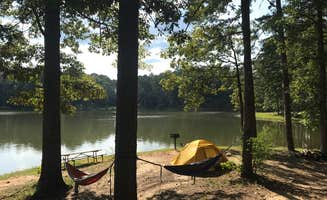Bienville National Forest provides multiple tent campsites near Ludlow, Mississippi for visitors seeking rustic outdoor experiences. This region offers predominantly primitive camping opportunities with minimal facilities. Camping season typically runs from spring through fall, with summer temperatures often reaching 90°F and high humidity levels common throughout the forest.
What to do
Hiking trails access: Shockaloe Base Camp I serves as an entry point to several hiking paths that wind through the mixed pine and hardwood forests. The trails vary in difficulty, with most being moderate in terrain challenge.
Wildlife observation: The forest hosts abundant wildlife including white-tailed deer, wild turkeys, and numerous bird species. Early mornings and evenings provide optimal viewing opportunities when animals are most active.
Fishing opportunities: Nearby streams and small lakes contain bass, bream, and catfish. A Mississippi fishing license is required, which can be purchased online or at local stores in Forest, approximately 12 miles from Shockaloe Base Camp I. "The ride out is a little rough. Pack in pack out. There is a restroom and water. ENJOY!" notes camper Daniel S.
What campers like
Natural seclusion: Campsites throughout Bienville National Forest offer significant distance between sites, providing privacy even during busier periods. Many primitive sites are accessible only by forest service roads.
Night sky viewing: Limited light pollution creates excellent stargazing conditions. Summer and early fall offer the clearest viewing when humidity levels drop in evening hours.
Seasonal wildflowers: Spring brings numerous wildflower species throughout the forest, particularly along stream edges and in forest clearings. Kosciusko Bicycle Only Camp along the Natchez Trace Parkway provides a specialized option for cyclists seeking to experience seasonal flora.
What you should know
Water availability: No reliable drinking water exists at most primitive sites in the forest. Campers must bring sufficient water supplies or purification equipment. The nearest reliable water source is at the ranger station or in nearby towns.
Road conditions: Forest service roads accessing tent campsites near Ludlow, Mississippi often become difficult after rain. High-clearance vehicles are recommended, particularly during spring and after summer thunderstorms. Access to some areas may become temporarily impossible after heavy rainfall.
Limited cell service: Most areas within Bienville National Forest have spotty or no cellular coverage. Inform others of your camping location and expected return date before entering remote areas.
Tips for camping with families
Kid-friendly activities: Bring nature identification guides specifically for Mississippi forests to engage children in plant and animal observation. Short, planned hikes with specific observation goals work best for younger children.
Safety preparations: The forest contains venomous snakes including copperheads. Teach children proper footwear requirements and to watch where they step or place hands. Bring a basic first aid kit with supplies for treating minor injuries.
Temperature management: Summer heat can be intense with temperatures regularly exceeding 90°F. Plan activities for early morning or evening, and ensure children remain properly hydrated. Consider camping during spring or fall for more moderate temperatures.
Tips from RVers
Size limitations: Most forest roads near Ludlow are unsuitable for larger recreational vehicles. Class B campervans and smaller trailers manage better on narrow, sometimes rough forest roads. Measure total vehicle length before attempting to navigate to primitive sites.
Generator restrictions: Forest service rules limit generator operation hours. Most primitive sites have no designated areas for generators, making solar power options more practical for extended stays.
Supply planning: No stores exist within immediate proximity to most camping areas. Stock all necessary supplies before arrival, and carry sufficient fuel as the nearest gas stations are in neighboring towns, typically 10-15 miles from camping areas.


